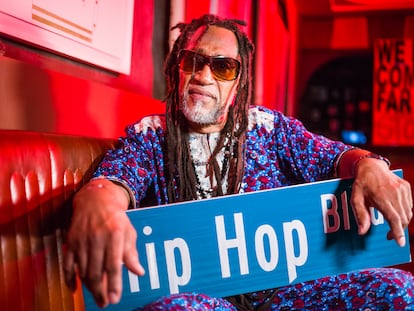Drill Generation: Wild rhymes for a youth without hope
Born in the marginal areas of Chicago, this musical genre is similar to rap, but with rawer lyrics, harder music and its own esthetic. It has recently arrived in Europe, reaching young people of diverse backgrounds. The themes of drill music deal with life on the street, violence and a lack of hope
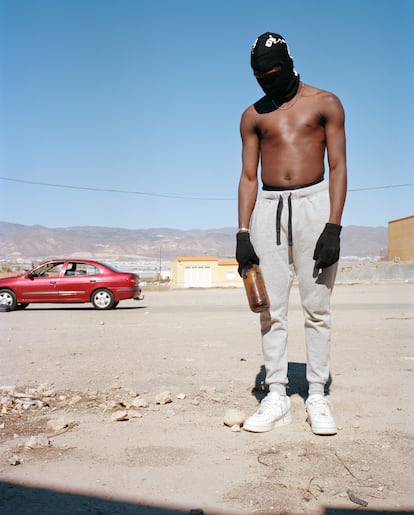
You can’t see the sea from here. It’s a hot summer morning and the humidity is sticky on the skin… a reminder that, even if it’s out of sight, the sea is only a few blocks away. However, from the 200 Homes neighborhood in the southern Spanish city of Roquetas de Mar, you cannot see the Mediterranean. Instead, you can only see an enormous white expanse that trembles in the wind, like a giant bridal veil that wraps the miles of land. This is known as the sea of plastic — a sea that tourists don’t come to look at.
As soon as you enter the neighborhood, a Civil Guard car slowly makes the rounds. This will happen two more times throughout the morning. The sun’s rays hit vertically and there are hardly any trees. In a bar in the Plaza de Andalucía — the central esplanade of the neighborhood, around which buildings rise in cracked white concrete blocks — cold, non-alcoholic cherry mojitos are served, while Arabic music plays. In a corner of the square, there’s a preacher of African descent, who seeks to capture souls with a microphone connected to a Bluetooth speaker. It’s Saturday — no one is paying much attention to him.
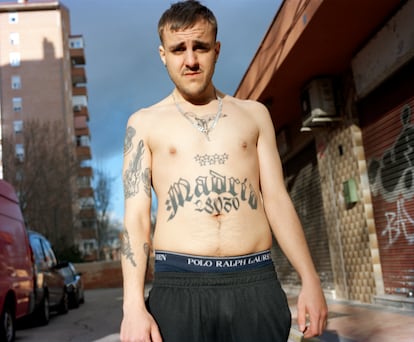
“My father worked in the fields when he came here,” says Key-21 (a stage name, like all those that appear in this report). “In the sea of plastic, the conditions are terrible. It’s very hard. You don’t leave the field. Kids [don’t want to turn out] like their parents.”
Most of the men who live in the 200 Homes neighborhood work in the sea of plastic. They are mostly of North Africa origin, having arrived in Spain between the late-1990s and the early-2000s. This is also the same sea that their children — nearly all of whom were born in Spain — have learned to hate.
These first-generation Spaniards dream of something more than picking tomatoes in a greenhouse. That’s why — when Key-21 walks through the neighborhood where he grew up — teenagers on bikes ride after him, with little kids running behind them. He’s a star. The son of a Mauritanian father and a Senegalese mother, he left the neighborhood as a young man and became a musician. The kid who started uploading songs to YouTube about life in the neighborhood now wears a luxury watch that shines in the sun, shorts from Burberry and a huge silver chain. For the teenagers of the 200, Key-21 is an aspirational idol: everyone wants to be like him. “Now the police no longer stop me, because they know that I dedicate myself to music. But when I was a minor, they stopped me constantly,” he recalls. An unmistakable sign of success.
In February of this year, Key-21 gave a concert with El Patrón 970, one of the undisputed stars of Spanish drill. Born in the neighborhood of Humanes (where the 970 postal code of the Madrid area comes from) to parents from Equatorial Guinea, El Patrón has more than 600,000 monthly listeners on Spotify. His most famous song — Jordan Manchás — has reached 46,700,000 views on YouTube. He’s also embroiled in a conflict with the rival Spanish drill camp, MDLR. Reflected in song lyrics and music videos, the beef between El Patrón 970 and the MDLR is laden with ridicule and territorial declarations.
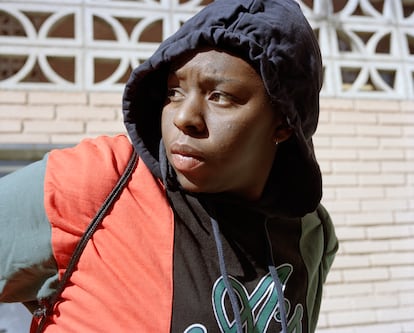
It’s difficult to define drill music. The short way to explain it would be to say that it’s a musical style whose branches come from the same tree from which the branches of rap and trap music also grow. Its lyrics are rawer, the music is harder and the main theme is life on the street. The long explanation is to repeat what all the “drillers” consulted in this report have said: “It’s not just music; it’s a way of life.” With all the consequences that this entails.
Drill music was born on the South Side of Chicago in 2010, among teenagers living in marginal neighborhoods, burdened by a murder epidemic. The violence they saw in their daily lives served as the common thread in most of their lyrics. They began to sing about the shootings, the stabbings, the harshness of neighborhoods and childhoods, in which the lack of opportunities and poverty permeated. These conditions created young people who now wear balaclavas or caps and meet up with their friends in the parks of their deserted neighborhoods, to sing the lyrics they write at night when they cannot sleep.
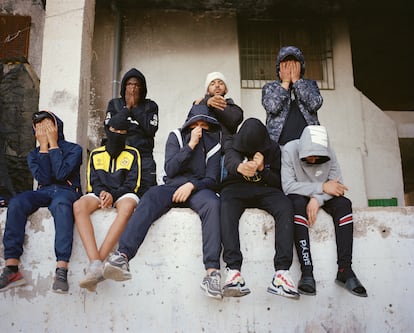
Music served as an outlet and success became a lifeline that could drag you to the surface, leaving the marginal world behind. Drill lyrics hardly have any metaphors. They’re raw, nihilistic, pessimistic, visceral, forceful and honest. In fact, honesty is one of the most valued themes in the genre, both in the music and the movement. Hence, the purist drillers demand that those who sing drill also live drill.
“I don’t see real guys in drill. What I see are children whose parents are giving them [an allowance] while they’re talking about killing people. You can’t do that. We kill and die. It is what it is. Nothing else. It’s ugly, but that’s life, you don’t want to let them kill you.” The speaker is Chacheblack: one of the greatest representatives of drill in Madrid. Chacheblack released his first album at the age of 16, in Villaverde, a district of the Spanish capital. “They [kicked me out of the community center] for being a kid from a broken family. I was on the street all day. When some friends told me we were going to do rap, I thought: ‘This is my thing.’”
His first album isn’t on YouTube, but the second one he released is: El Puto Negro del Cole (The Motherfucking Black Guy from School). He was referring to himself. At 16, Chacheblack lived on the streets, as he had problems with his alcoholic mother and stepfather. Despite this, the largest chain he wears around his neck is a huge medallion full of shiny crystals and a photograph of his mother giving him a kiss. On the back is the date of her death.
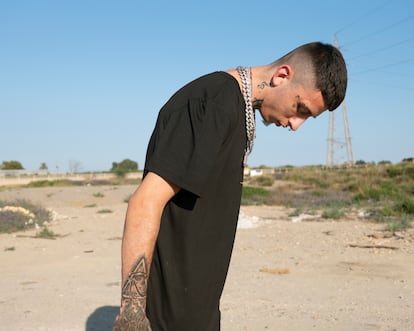
When Chacheblack sings — ”We’re prepared in case anyone wants war… They don’t know what I’ve done to fill my fridge” — he assures EL PAÍS that he tells it like it is. “Drill is everything that isn’t seen. It’s reality, [like the] stabbings. That’s why we’re packing heat. Those people who sing about things they haven’t done will meet us in the street one day… and we’ll slap them around,” he affirms, while sitting in a place that he doesn’t want named in the article, smoking a joint. Chacheblack also doesn’t answer when I ask him if the weapons in his music videos are real.
The drill singer Slow has just tattooed — above the collar of his shirt — the words “Drill Mafia.” This is the name of the most famous drill studio in Madrid. It’s based in Vallecas, in a storage area where it coexists with wholesale offices, medical marijuana dispensaries and a junkyard. The studio — which opened about three years ago — is furnished with wrought iron garden furniture that looks like someone threw it away. There’s a small refrigerator, a PlayStation 4 connected to a plasma TV and the crown treasure: a desk with a computer and a mixer, into which Slow has invested a large part of Drill Mafia’s budget to improve the quality of the music he produces.
After buying everything, he put an alarm system and cameras in his studio, even though nobody has ever tried to rob him. “Everyone knows where we are and whoever wants trouble, the doors are open,” he shrugs. What the cameras have recorded are several police inspections that Slow assures us are repeated from time to time. In the video shown to EL PAÍS, the agents enter the production company to ask the teenagers for their documentation. After checking everything, they leave.
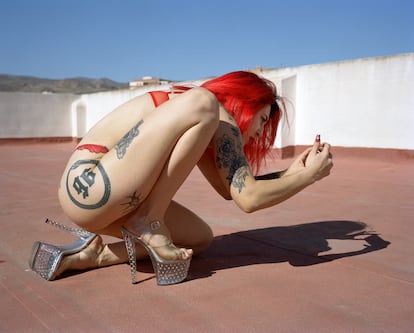
Despite running a production company whose artists accumulate 100,000 monthly listeners, Slow never studied music. “I led a complicated life and I chose this. It was a way out for me.” Right now, he has about 50 amateur singers under his label who want to go pro. Teenagers use his studio not only to record their songs, but also as a place to decompress and meet up when they’re having a hard time at home or at school.
“I’m trying to teach the kids that music is a path forward,” Slow explains. “There are all kinds of things [happening in this neighborhood] — the vibes aren’t always good. Drill is very dark and many kids come from reform schools, but that’s the system’s fault, not the kids’. We just [take in these youth] and show them an escape route.” His main job isn’t to help them make good music, but rather, to give them a sense of security.
For $35 to $50, he can produce a song. He never says no to anyone. “We’re not going to judge anyone based on where they come from. [We only care] where they end up.”
On a terrace of a bar in the satellite city of Fuenlabrada, about 10 miles from Madrid, Skinny and Four gather around a table. They’ve both sung drill, although Skinny is barely dedicated to music nowadays (he’s about to start working in a bar as a waiter), while Four releases trap songs only every once in a while. They’re both close to the 970 troupe. During their interview with EL PAÍS, they debate about music and life on the street. An excerpt from a conversation between the two men is below:
Skinny: The only thing I don’t understand is why, in Spain, all the subnormals become famous. Like Bb Trickz.
Four: Bb Trickz has an agent, he’s been making ads since he was five-years-old. He was in a strawberry Nesquik advertisement.
Skinny: But making an advertisement doesn’t give you the right to be a musician!
Four: Bro, being a politician doesn’t give you the right to steal! For me, you can’t sing drill if you can’t do what you sing about on the street. If you’re not going to shoot in the street, don’t sing drill. Because by singing drill, you’re asking to be robbed.
Flaco: Well, I’ve been all over Madrid and no one has robbed me.
Four: Cousin, what were you carrying that was so valuable they would have wanted to snatch it from you?
Skinny: Lots of things, brother. What’s valuable for you?
Four: A gold bracelet, some sneakers… something that can be seen. You try to catch me, come and rob me, you know how it can end.
Skinny: Well, I’ll beat you.
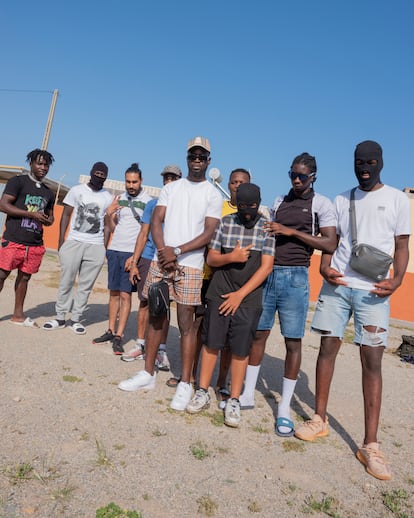
The absence of women in drill is often explained by the amount of testosterone poured into the lyrics. The violence and aggressiveness means that the female singers end up fusing sounds and drifting more towards trap, rather than towards the street rawness of drill. “At first, I didn’t care that there were so few women in drill. But now, I think that I would like there to be many more,” confesses Lilmmei, one of the few women currently doing drill in Spain. “When I go to the studio, I always try to collaborate with someone, I try to be [like] an auntie. Especially if [the female singer] isn’t well-established.”
Lilmmei has lived all her life in Valencia. Born to Nigerian parents, the young woman has just finished her certification to become an X-ray technician. From the start, she ignored the siren songs of music and fame, deciding to get a real job. On the side, she started doing pure rap and uploading her videos to Instagram. Then, someone told her about drill. She was encouraged to give it a chance. Today, other female drillers on the Spanish scene include Rain Von, Aya Ayat and Omaigold — all of them hailing from immigrant backgrounds. For Lilmmei, drill was a way to rise, but she still considers the genre to be fleeting.
“I don’t see a future for drill in Spain,” she sighs.
Although drill was born in the United States, it was in the United Kingdom where it experienced a true explosion in popularity. While it remains marginal and underground in Spain — a music that only plays on the street or in the marginal neighborhoods — in the United Kingdom, it has reached the radio and bars. But it was precisely this popularity that condemned the movement to being persecuted. The London police have requested the removal of drill videos from YouTube several times, because they claim that it “increases violence in [the inner-city].”
Rondodasosa — the most famous Italian driller — was banned from performing in pubs and venues in Milan for two years, after riots broke out at a nightclub. Morad, meanwhile, has been banished by the police from La Florida, his neighborhood in Madrid, “for encouraging riots.”
For Slow, however, drill isn’t violence. “Drill is the art that reflects the system as it is. For the police, the fault lies with the music — not with the system, not with the stores that sell machetes. They could regulate [those weapons] like they regulate alcohol and tobacco,” he argues.
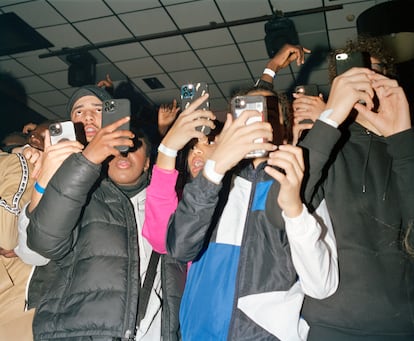
One of the characteristics of the genre is how young all its stars are. Chief Keef — the first and greatest drill artist in Chicago — was only 16-years-old when he signed his first contract. In Spain, Chacheblack is 31-years-old and the oldest of everyone EL PAÍS spoke to. Slow is 29. Skinny and Four are 27 and 25 respectively. Lilmmei and Kid Flako are 21-year-olds.
Kid Flako is the only drill star in this report willing to reveal his real name: Alejandro Ruiz. He also notes that he no longer does drill. “I don’t like the whole fantasy that exists and the movie that they’re inventing about drill. As soon as you see the faces [of the singers], you can tell if they’ve really gone through [hell] or not. And someone with a perfect face and a hairline — who got his eyebrows done at the barbershop — when he’s telling me that he’s hungry and that he’s the baddest, [I know] that’s a lie.”
“I know many people who are [badly off]. I’ve been [broke] for a month, I’ve literally only been eating milk and cookies for a month,” he confesses.
Ruiz started making music very early on in life. At the age of 14, he had already recorded in a studio. Now, he has his own, where he records everything from trap to reggaeton to Christian rock. One day, he even recorded an opera. Having not studied music, he learned everything he knows about editing and producing songs through YouTube and the internet.
One of the characteristics of drill is precisely the ability to create music with very few elements. With few means, teenagers record videos of each other and post them on YouTube, hoping they catch on. In addition to the lyrics, the aesthetics in the video are very important: clothing that is almost always black, sweatpants, puffy jackets, hoods, chains, balaclavas (no face, no case!) fanny packs, tattoos and branded clothing with giant logos (although the amateurs almost always wear pirated outfits, trying to imitate famous drillers).
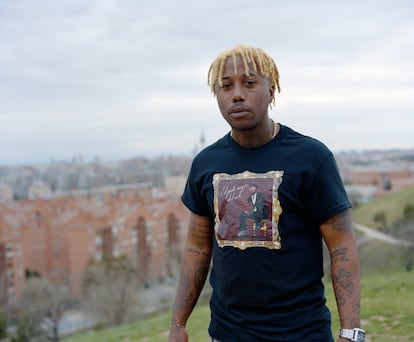
The general feeling is that we’re on the verge of something new. The social revolution that has yet to break out in Spain or the United States has already begun to flare up in the U.K. and the banlieues of France. To talk about drill is to talk about the generation that has lost all faith in social progress… or never believed it was possible in the first place. It’s also a way of channeling the frustration of young people of immigrant backgrounds in marginal neighborhoods, using the lyrics and sounds to claim their origins and emphasize their existence. They want the flashes, the listens and the likes that validate them. They want the admiration of their loved ones.
Drill sings to real life, to a complicated childhood, to the hardness of the asphalt and the suffocation of the dust. The general feeling is that we’re facing a generation that — more than simply feeling dissatisfied — feels abandoned. The police are the enemy. The press are merely the creeping arm of the law. Most of those interviewed in Spain didn’t know what EL PAÍS was… although everyone asked if the photos from this report would be posted to Instagram.
They live on the shore. On the border of a world that never lets them enter. “You want to be part of a society and you want to have a normal job and be trusted. But if you come from world B, they don’t even give you the simple opportunity to try. Drill is the way of life that we young people lead as a protest against the oppression of the state. It’s the same as always: that we are anti-system,” Chacheblack declares. Drill music is the only life vest they can hold onto. At least, in this world, the rules were written by them.
Sign up for our weekly newsletter to get more English-language news coverage from EL PAÍS USA Edition
Tu suscripción se está usando en otro dispositivo
¿Quieres añadir otro usuario a tu suscripción?
Si continúas leyendo en este dispositivo, no se podrá leer en el otro.
FlechaTu suscripción se está usando en otro dispositivo y solo puedes acceder a EL PAÍS desde un dispositivo a la vez.
Si quieres compartir tu cuenta, cambia tu suscripción a la modalidad Premium, así podrás añadir otro usuario. Cada uno accederá con su propia cuenta de email, lo que os permitirá personalizar vuestra experiencia en EL PAÍS.
¿Tienes una suscripción de empresa? Accede aquí para contratar más cuentas.
En el caso de no saber quién está usando tu cuenta, te recomendamos cambiar tu contraseña aquí.
Si decides continuar compartiendo tu cuenta, este mensaje se mostrará en tu dispositivo y en el de la otra persona que está usando tu cuenta de forma indefinida, afectando a tu experiencia de lectura. Puedes consultar aquí los términos y condiciones de la suscripción digital.
More information
Archived In
Últimas noticias
The new victims of the Republican war on Obamacare: Millions hit by soaring health insurance premiums
A country divided on migrant rights: Some US states expand protections while others restrict them
Venezuela authorizes the release of another 87 political prisoners
There is as much life left to discover on planet Earth as that which is already known
Most viewed
- David King, chemist: ‘There are scientists studying how to cool the planet; nobody should stop these experiments from happening’
- Reinhard Genzel, Nobel laureate in physics: ‘One-minute videos will never give you the truth’
- Oona Chaplin: ‘I told James Cameron that I was living in a treehouse and starting a permaculture project with a friend’
- Sinaloa Cartel war is taking its toll on Los Chapitos
- The Interoceanic Train, the Mexican alternative to the Panama Canal


